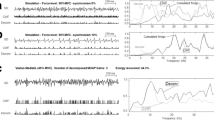Abstract
The criterion normally used to identify a potential generated by a single muscle fibre (SFAP) is that it must have identical shape at consecutive discharges. Technical problems accompanying the recording of single-fibre electromyographic (SFEMG) potentials introduce certain variability in the shape of these potentials, thereby compromising the ability to detect pure SFAPs. This study aims to determine the conditions necessary for two fibres to generate a compound potential that fulfils the single-fibre criterion. This has been done by analysing the alterations in the waveform of compound spikes formed by the summation of two SFAPs whose relative weight in the composite potential can differ considerably. Several factors responsible for this shape variability, with a geometrical, physiological or accidental origin, have been included in our study. It has been shown that a distant interfering component will be hardly detected in the composite potential if it is smaller than approximately 15 % of the main component. For this interfering component to generate a notch in the rising phase of the compound potential, it must be greater than about 30 % of the main component. A compound potential will fulfil the single-fibre criterion if the time dispersion between the individual components is less than 80–120 μs. These results permit the estimation of the amplitude of interfering potentials so they could be useful in fibre density studies. The article also emphasises the inherent variability of SFEMG potentials and the impact of this variability on jitter estimation.
Similar content being viewed by others
References
Andreassen S, Arendt-Nielsen L (1987) Muscle fibre conduction velocity in motor units of the human anterior tibial muscle: a new size principle parameter. J Physiol 391: 561–571
Baker DJ, Cross NL, Sedgwick EM (1987) Normality of single fibre electromyographic jitter: a new approach. J Neurol Neurosurg Psychiatry 50(4): 471–475
Bromberg MB, Scott DM (1994) Single fiber EMG reference values: reformatted in tabular form. AD HOC Committee of the AAEM single fiber special interest group. Muscle Nerve 17: 820–821
Buchthal F, Guld C, Rosenfalck P (1955) Innervation zone and propagation velocity in human muscle. Acta Physiol Scand 35(2): 174–190
Buchthal F, Guld C, Rosenfalck P (1957) Volume conduction of the spike of the motor unit potential investigated with a new type of multielectrode. Acta Physiol Scand 38(3–4): 331–354
Daube JR, Rubin DI (2009) Needle electromyography. Muscle Nerve 39(2): 244–270
Dimitrov GV, Dimitrova NA (1998) Precise and fast calculation of the motor unit potentials detected by a point and rectangular plate electrode. Med Eng Phys 20: 374–381
Ekstedt J (1964) Human single fibre action potentals. Acta Physiol Scand 61(226): 1–96
Ekstedt J, Stålberg E (1973) How the size of the needle electrode leading-off surface influences the shape of the single muscle fibre action potential in electromyography. Comp Prog Biomed 3: 204–212
Ekstedt J, Nilsson G, Stålberg E (1974) Calculation of the electromyographic jitter. J Neurol Neurosurg Psychiatry 37(5): 526–539
Hakelius L, Stålberg E (1974) Electromyographical studies of free autogenous muscle transplants in man. Scand. J Plast Reconstr Surg 8: 211–219
Kimura J (1989) Electrodiagnosis in diseases of nerve and muscle. Davis, Philadelphia
Lagueny A, Le Masson G, Burbeaud P, Deliac P (1998) Single fibre electromyography in multifocal motor neuropathy with persistent conduction blocks. J Neurol Neurosurg Psychiatry 65(3): 357–361
Lange DJ (1992) Single fiber electromyography in normal subjects: reproducibility, variability, and technical considerations. Electromyogr Clin Neurophysiol 32(7–8): 397–402
Lööf Y (1990) Improving electromyographic jitter measurements by analysis of the firing pattern. IEEE Trans Biomed Eng 37(11): 1105–1114
Ludin H (1973) Action potentials of normal and dystrophic human muscle fibres. In: Desmedt JE (ed) New development in electromyography and clinical neurophysiology. Karger, Basel, pp 400–406
Morita G, Tu YX, Okajima Y, Honda S, Tomita Y (2002) Estimation of the conduction velocity distribution of human sensory nerve fibers. J Electromyogr Kinesiol 12(1): 37–43
Nandedkar S, Stålberg E (1983) Simulation of single muscle fibre action potentials. Med Biol Eng Comput 21: 158–165
Nandedkar S, Sanders DB (1988) Simulation of concentric needle EMG motor unit action potentials. Muscle Nerve 11: 151–159
Nishizono H, Kurata H, Miyashita M (1989) Muscle fibre conduction velocity related to stimulation rate. Electroencephalogr Clin Neurophysiol 72: 529–534
Rodríguez J, Dimitrovna NA, Dimitrov GV, Gila L (2011) Shape variability of potentials recorded by a single-fiber electrode and its effect on jitter estimation. Ann Biomed Eng 39(2): 812–823
Sanders DB, Howard JF Jr, Johns TR (1979) Single-fiber electromyography in myasthenia gravis. Neurology 29(1): 68–76
Sanders DB (1987) The electrodiagnosis of myasthenia gravis. Ann NY Acad Sci 505: 539–556
Stålberg E (1966) Propagation velocity in human muscle fibres in situ. Acta Physiol Scand 287: 1–112
Stålberg E, Ekstedt J, Broman A (1971) The electromyographic jitter in normal human muscles. Electroencephalogr Clin Neurophysiol 31(5): 429–438
Stålberg E, Ekstedt J, Broman A (1974) Neuromuscular transmission in myasthenia gravis studied with single fibre electromyography. J Neurol Neurosurg Psychiatry 37(5): 540–547
Stålberg E (1977) Electrogenesis in human dystrophic muscle. In Rowland LP (ed) Pathogenesis of human muscular dystrophies. Excerpta Medica, Amsterdam, pp 570–587
Stålberg E, Trontelj J (1979) Single fibre electromyography. Old Woking, Mirvalle, Surrey
Stålberg E, Dioszeghy P (1991) Scanning EMG in normal muscle and in neuromuscular disorders. Electroencephalogr Clin Neurophysiol 81(6): 403–416
Stålberg E, Sonoo M (1994) Assessment of variability in the shape of the motor unit action potential, the “jiggle,” at consecutive discharges. Muscle Nerve 17(10): 1135–1144
Stålberg E, Sanders B (2009) Jitter recordings with concentric needle electrodes. Muscle Nerve 40: 331–339
Schwartz MS, Stålberg E (1975) Myasthenia gravis with features of the myasthenic syndrome. An investigation with electrophysiologic methods including single-fiber electromyography. Neurology 25(1): 80–84
Wallinga W, Gielen FLH, Wirtz P, de Jong P, Broenink J (1985) The different intracellular action potentials of fast and slow muscle fibres. Electromyogr Clin Neurophysiol 60: 539–547
Author information
Authors and Affiliations
Corresponding author
Rights and permissions
About this article
Cite this article
Rodriguez-Falces, J., Gila, L. & Dimitrova, N.A. Evaluation of the criteria to identify single-fibre potentials in human muscle fibres. Biol Cybern 106, 323–338 (2012). https://doi.org/10.1007/s00422-012-0500-z
Received:
Accepted:
Published:
Issue Date:
DOI: https://doi.org/10.1007/s00422-012-0500-z




